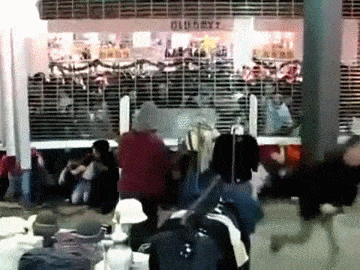So how was your Memorial Day Weekend?
Hello, and welcome to Tuesday that’s actually a Monday—like any of us know what day it actually is. Also, hello new readers. Welcome to ... whatever this is.
In the before times, Memorial Day Weekend served as the unofficial start to the summer, as we get ready for nicer weather and summer Fridays.
Personally, it’s the official start of my convertible pants season. Look, it gets hot commuting and the ability to wear shorts while walking and then throw on the zip pants when I get to the office is incredibly satisfying. I prefer this to bringing an extra pair of clothes. We all have hills we’ll die on. This is mine.
In retail, however, the holiday serves as a pretty good promotional vehicle.

(Image via Getty)
“From a retail perspective, Mother’s Day and Father’s Day are more significant than Memorial Day,” Matt Kaden, managing director at MMG Advisors, a boutique investment bank for the retail industry, told me. “[Memorial Day Weekend] is the last chance to get some good selling before the dead of summer, where you typically see lulls.”
(Some interesting data here on this year’s Mother’s Day.)
Womply, looking at 2017 data, found that the week leading up to Memorial Day Weekend is typically a boon for local businesses.
“the week leading up to Memorial Day is the 4th-best week of the year for revenues at local bars and lounges, gardens and nurseries, and landscaping and gardening services. And it’s the 3rd-best week of the year for furniture and appliance stores. That’s better than their Black Friday sales week, which is their 8th-best week for revenue.”
(The company also noted that Memorial Day itself is not very great for local businesses, which makes sense as we’re all gorged up on burgers and hot dogs and beer.)
According to 2019 data from WalletHub, 45.5 percent of Americans were “likely” to shop for sales, spending an average of $486 over the weekend.
In order to have this kind of success, companies need to get folks through the door.

And that means ads. Lots and lots of ads.
Last year, ZypMedia found that the top advertisers for the week leading up to and including Memorial Day were: food and drink category (30 percent), home and garden (28 percent) and automotive (18 percent), health and fitness (15 percent), arts and entertainment (9 percent).
The company also saw “the highest-performing click-through rate from May 17-27, 2019, and the average video-completion rate (VCR) was 96 percent for OTT campaigns.”
This year, however, Memorial Day Weekend is different.
While sales data from last week are not out yet, we can guess that due to the coronavirus, whatever signals we saw in previous years, they aren’t the same this year.
One thing I’ve noticed (now that I have plenty of time on my hands), is that even though companies have pulled ad spend en masse, there are sure still a lot of ads. Of course, many companies had already paid for ads for this time period, and instead of creating new spots, used B-roll or older footage to run campaigns.
So I asked around about what it means, and, in broad strokes, what happened was that lots of companies panicked (rightfully!) at the onset of the outbreak. Companies had a litany of concerns, as they had never seen a pandemic blow across the globe, forcing businesses to close and people to stay indoors. We know this. We are still in it.
But the deep fears of a rapidly spreading illness created a domino effect. With manufacturers and stores closing, the whole selling supply chain was chopped off at the knees. With no product being made, there’s not a lot to market.
On top of that, ad agencies also closed, which created different concerns for companies: even brands that had product to sell didn’t have creative teams to produce the ads.
This, in turn, clobbered publishers: no product, no marketing, no advertising, no revenue. Layoffs. Furloughs. Disaster. Again, from the ‘things we know’ department.
What’s interesting, however, is that while some businesses are still in a really bad spot, a lot of businesses have also gotten their act together and can respond to a new normal.
At the same time, we’re seeing a flood of digitally native brand advertisers looking to pick up on some low priced TV and even some of the lower priced digital inventory, which, sources tell me, have flipped a bit—some typically high-priced digital inventory is now being flipped for cheaper rates. Indeed, a CNBC piece today highlights a Goldman Sachs report focusing on Europe and how the shift from tv spend to digital on the continent has exacerbated since the pandemic.
As the summer months pick up, watch for a couple of things:
Publishers about to get clobbered for deals done in Q1; with a Net 60-90 payment plan, companies aren’t about to pay out, which can spell trouble for media companies.
Direct advertising to boom
Convertible pants
Little Feat, “Tripe Face Boogie”
Thank you for allowing me into your inbox each day. If you have tips, or thoughts about this newsletter, drop me a line!
Some interesting links:
Desperate workers rush to delivery app jobs to find low pay and punishing rules (Washington Post)
Democratic bills aim at cracking down on targeted political ads on Facebook and Google (CNBC)
Riot Games adds In-Game Sponsor Banners to League of Legends Esports (eSport Observer)
The store of the future is coming this summer. Here’s what it looks like. (Modern Retail)
The Facebook Friends Moms Don’t Want? Their Teens (WSJ)
TikTok’s in-app revenue surges during lockdown (Bloomberg)
The CEO of Hertz will get a $700,000 payday as his 103-year-old company crumbles into bankruptcy (Business Insider)
Two years into new EU privacy regime, questions hang over enforcement (Politico)
Facebook Executives Shut Down Efforts to Make the Site Less Divisive (WSJ)



